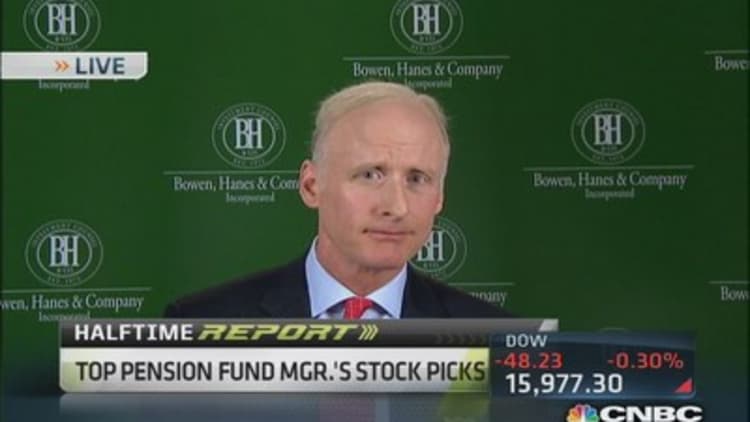
Investors are confronting the potential of an unfamiliar scenario in 2014: For the first time since the fall of 2011 they likely won't have the Federal Reserve backing them up.
If things go according to market expectations, the central bank within the next couple of months will begin reducing, or tapering, its $85 billion monthly bond-buying program known as quantitative easing.
The change could feel imperceptible at first. The Fed probably will only cut incrementally each month—$7 billion to $10 billion—but by the time the year ends, QE probably will be in the rearview mirror.
"It is time to stop talking about tapering," Matthew Hornbach, Morgan Stanley's head of U.S. interest-rate strategy, said in a note to clients. "Instead, we need to start talking about what level of accommodation the Fed will want to provide to the economy at its upcoming meetings."
Hornbach believes the market is pricing in a 66 percent probability that the Fed tapers either at its Open Markets Committee meeting next week or the one in January. Just a few weeks ago, consensus had it that the first move wouldn't happen until March, but that has changed since the economy, particularly employment, has shown improvement.
(Read more: Job creation climbs in November)
Full-throttle Fed intervention has been the case since September 2011, when the central bank and Chairman Ben Bernanke dashed in to save a market that had tumbled more than 18 percent and an economy that faced threats both domestic and foreign.
The has soared more than 54 percent since the Fed began that intervention—first with the balance sheet-neutral "Operation Twist," followed by the open-ended "QE Infinity" that cranked up a year later and has brought the Fed's balance sheet to the cusp of $4 trillion in electronically created funds.
With the Fed taking a slow walk to the sidelines, diminished returns ahead seem to be on the minds of many market participants.

"Compared to bonds, equities are favorably valued," Asoka Woehrmann and Randy Brown, co-chief investment officers at Deutsche Bank, said in a 2014 preview analysis. "However, investors know that this relationship is skewed by quantitative easing."
Deutsche estimates the S&P 500 will advance to 1,900 by the end of 2014, a 6 percent gain from current levels that would pale next to 2013's surge of 26 percent. Reduced expectations from Fed stimulus and a modest rise in interest rates feed the belief among many analysts that the coming year will be considerably less stellar than the current one.
Still, the Deutsche team believes there will be opportunities, though the landscape will change. Fed officials have maintained they will use economic data as a guidepost to QE policies, and the "open-ended" designation to the third round of easing was a signal that the Fed will step back into the money-printing business should conditions deteriorate.
(Read more: Retail, big-money crowds heading in opposite ways)
"The moderate interest rate increase that we expect should place only a minor strain on equity markets," they said. "Nevertheless, we believe that the markets' attention could shift away from companies from the utilities and consumer staples sectors which are more sensitive to interest rate changes."
Jay Bowen, CIO and economic strategist at Bowen Hanes in Tampa, Fla., believes market performance will hinge on the Fed's motivation for tapering and, ultimately, raising rates, though that is not expected to happen for a few years.
"The market will applaud and welcome the normalization of interest rates if it's occurring for the right growth-oriented reasons," he told CNBC.
(Read more: Sorkin: Bernanke may taper by year-end)
Opportunities will arise in industrial stocks, said Bowen, whose nickname "The Oracle of Tampa" makes him the Southern counterpart of Nebraska's Warren Buffett, "The Oracle of Omaha."
Bowen likes industrials "based on relative valuation and global growth prospects." He also likes growth in shale-related industries as well as railroads, specifically Canadian National.
(Read more: Waiting for taper start? You may have missed it)
Still, the road to post-QE gains is likely to be rocky.
"In terms of implications for investors, you need to break it down between short-term and longer-term," said Paul Mangus, head of equity research and strategy for Wells Fargo Private Bank. "In the short run, based on what we've seen so far, evidence suggests that investors may view tapering as a short-term headwind for the marketplace.
"If you look a little longer term, [reduced QE] would be evidence of an improved confidence in the economy. The question is whether investors are becoming more comfortable with reduced Fed activity and whether that comfort level has yet been reached. It doesn't appear as though they are."
Mangus thinks options are a good hedging strategy here.
(Read more: Retail, big-money crowds heading in opposite ways)
And for those feeling even more skittish about diminished Fed involvement, he said there's one old-fashioned way to get some protection: Rebalancing.
Outsized market gains usually lead to investor portfolios that are out of whack in terms of asset class allocations, and he sees the Fed uncertainty as a good time to cash in on the year's rally.
"The one thing we have been talking to clients about for a while now is maintaining that discipline and knowing that it's OK to take profits if your portfolio has reached a point where you're significantly overweight your long-term allocation," Mangus said. "Having said that, we're still constructive long-term on the equity market."
—By CNBC's Jeff Cox. Follow him on Twitter @JeffCoxCNBCcom.






